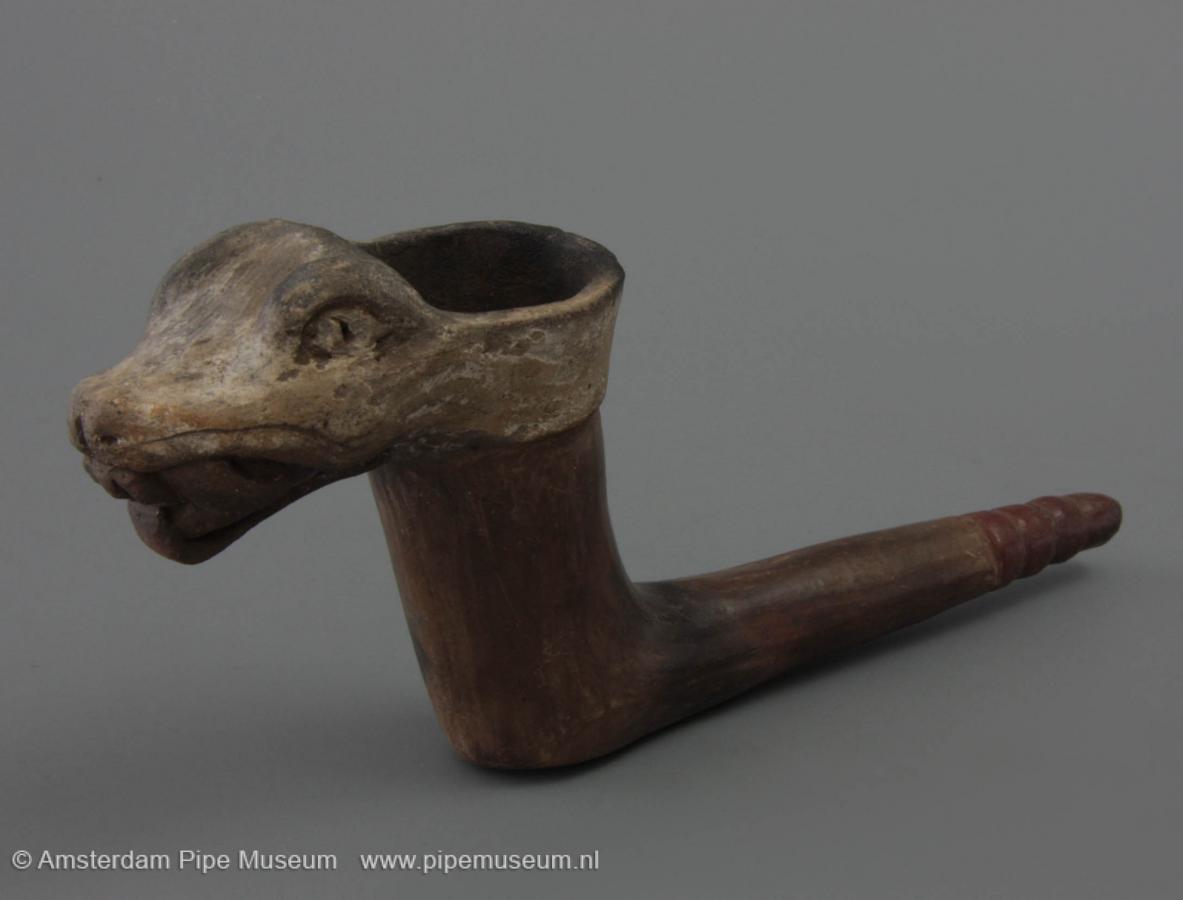Numéro de la collection:
| APM 20.503 |
Sous-collection:
| pipes préhistoriques |
Titre:
| pipe à tabac |
Mots-clés:
| head snake |
Description :
Tobacco pipe made of earthenware with an elbow shape with a high cylindrical bowl, the upper side is figurative, with a flat bottom without a heel in a straight stem, diluting to the end with four knots as a mouthpiece. Bowl opening head of a rattlesnake with open mouth the double-pointed tongue along the lowerside of the head, decoration accentuated with yellow-white slip. Bowl lower half and stem polished, the mouthpiece red polished slip. |
Date:
| Période | 900 - 1300 |
Tailles:
| General | Hauteur | 8,8 cm |
| Largeur | 3,6 cm | |
| Longueur | 19 cm | |
| Fourneau | Hauteur | 7,3 cm |
| Largeur | 3,2 cm | |
| Stem | Longueur | 11 cm |
Caractéristiques
| Type de pipe | pipe à tuyeau |
| Forme de pipe | figuratif |
| Matérial | poterie (céramique) |
| Technique | formé à la main |
| Couleur | marron |
| Dernière touche | engobe, grijswit |
| Traces of use | gerookt |
Production
| Continent | Amérique du Nord |
| Région internationale | Amérique centrale |
| Pays | Mexique |
| Région nationale | Tlapacoya |
Statut juridique
| Date | 2011 |
| Ancienne appartenance | Groningen, Niemeyer Tabaksmuseum, c. 1975-2011, nr DD011 |
| Tilburg, Ted van Dijck, c. 1975 |
Commentaire
| Het tekstbordje bij Niemeyer vermeldt: Pijp met slangenkop, aardewerk, ca. 500 voor Chr. Mapacoyan (sic.), Mexico. De beschrijving van Turfschip-exposite in Breda (1981) meldt als datering 800-300 v. Christus. Ketel achterzijde ingeboord voor thermoluminiscentierapport (niet meer aanwezig). |
Literature
| Georg Alfred Brongers, Van Gouwenaar tot bruyère pijp. Amerongen, 1978. p- 7. Dit exemplaar. Bijschrift: Pijp in de vorm van een ratelslang, donkerroodbakkende klei met verschillende donker getinte slib overtrokken. Afkomstig uit Tlapacoya, Mexico, 800-300 v. Chr. L. 16,5 cm, h. 8,5 cm. |
| Ted van Dijck, Eeuwenoude Indiaanse pijpen in een Nederlands museum, Dl. I & II. Antiekwereld, III/11 & 12, 1978. II, p 8, afb 2. Dit exemplaar. Bijschrift: Azteekse pijp uit Tlapacoya, Mexico. |
| Anoniem, The Niemeyer Tobacco Museum in Groningen. TJI Tobacco Journal International, /6, 1978. p 404. Dit exemplaar. Bijschrift: Backed clay pipe in the shape of a rattle-snake. Mexiko, 800-300 B.C. |
| Bep van der Linden-Nijdam, Pijpen: rookinstrumenten van oudsher Tabaksdozen: fraaie bergplaatsen voor het dure produkt. Kunst- & Antiekrevue, VI/4, 1980. p 19. Dit exemplaar. Bijschrift: Pijp uit roodbakkende klei met donkere slib overtrokken. Mexico, 800 - 300 v. Chr. Let op de prachtige verhoudingen, waarbij de maximale hoogte de helft van de totale lengte bedraagt. Niemeyer Ned. Tabacologisch Museum, Groningen. |
| Georg A. Brongers (Georg Alfred Brongers), 60 pijpen uit de collectie van het Niemeyer Nederlands Tabacologisch Museum. Groningen, 1981. p 6. Dit exemplaar. Bijschrift: Pijp waarvan de vorm verwijst naar een ratelslang. De ratel vormt het mondstuk en de pijpholte is in de kop verwerkt. Gebakken klei, Tlappacoya, Mexico, 800-300 v. Chr. |
| Gustav Casparek et al., Von der Leidenschaft des Pfeifenrauchers. Bielefeld, 1984. p 4/15. Dit exemplaar. Bijschrift: Diese Tonpfeife in Gestalt einer Klapperschlange stammt von den Tlapacoya (Mexiko) und wurde zwischen 800 und 300 v. Chr. gearbeitet. |
| Ralph Plum, ed., La passion de la pipe, fumée et fumeurs. Bielefeld, 1984. p 4/15. Dit exemplaar. |
Exposition
| Groningen, Niemeyer Tabaksmuseum, 1978-2010, zolder. |
| Breda, Turfschip, tentoonstelling "Toeback-Tabak", 11-20 april 1981. |
| Amsterdam, Pijpenkabinet, tentoonstelling "Roken bij de Amerikaanse Indianen, voorhistorische pijpen uit de Niemeyer collectie", 1 augustus - 14 september 2011. |
If you have any comments, suggestions or additions, click here to send us an email










